Netizens exposed the embedding technology used in OpenAI's new model
A few days ago, OpenAI had a major update and announced 5 new models in one go, including two new text embedding models.
Embedding is the use of numerical sequences to represent concepts in natural language, code, etc. They help machine learning models and other algorithms better understand the relationships between content and make it easier to perform tasks such as clustering or retrieval.
Generally, using larger embedding models (such as stored in vector memory for retrieval) consumes more cost, computing power, memory and storage resources. However, the two text embedding models launched by OpenAI offer different options. First, the text-embedding-3-small model is a smaller but efficient model. It can be used in resource-limited environments and performs well when handling text embedding tasks. On the other hand, the text-embedding-3-large model is larger and more powerful. This model can handle more complex text embedding tasks and provide more accurate and detailed embedding representations. However, using this model requires more computing resources and storage space. Therefore, depending on the specific needs and resource constraints, a suitable model can be selected to balance the relationship between cost and performance.
Both new embedding models are performed using a training technique that allows developers to trade off the performance and cost of embedding. Specifically, developers can shorten the size of the embedding without losing its conceptual representation properties by passing the embedding in the dimensions API parameter. For example, on the MTEB benchmark, text-embedding-3-large can be shortened to a size of 256 but still outperforms the unshortened text-embedding-ada-002 embedding (of size 1536). In this way, developers can choose a suitable embedding model based on specific needs, which can not only meet performance requirements but also control costs.
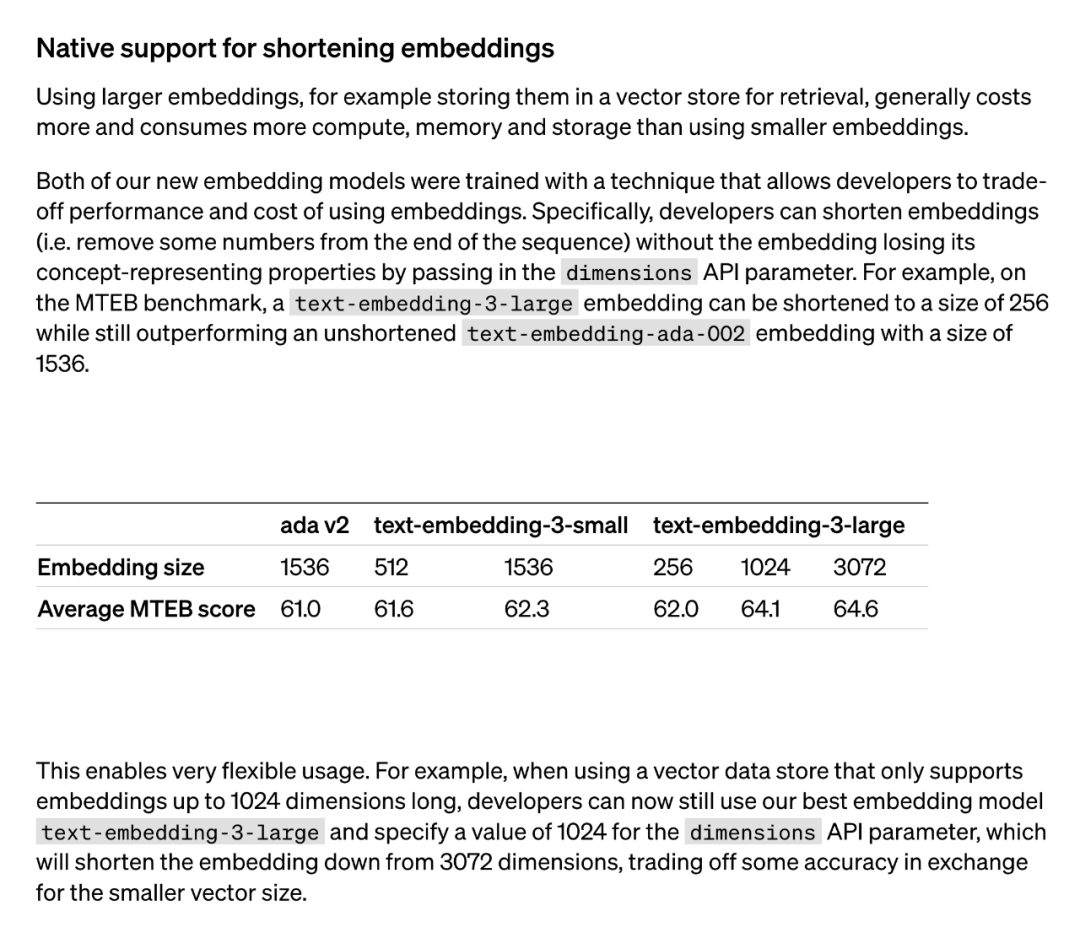
#The application of this technology is very flexible. For example, when using a vector data store that only supports embeddings up to 1024 dimensions, a developer can select the best embedding model text-embedding-3-large and change the embedding dimensions from 3072 by specifying a value of 1024 for the dimensions API parameter. shortened to 1024. Although some accuracy may be sacrificed by doing this, smaller vector sizes can be obtained.
The "shortened embedding" method used by OpenAI subsequently attracted widespread attention from researchers.
It was found that this method is the same as the "Matryoshka Representation Learning" method proposed in a paper in May 2022.

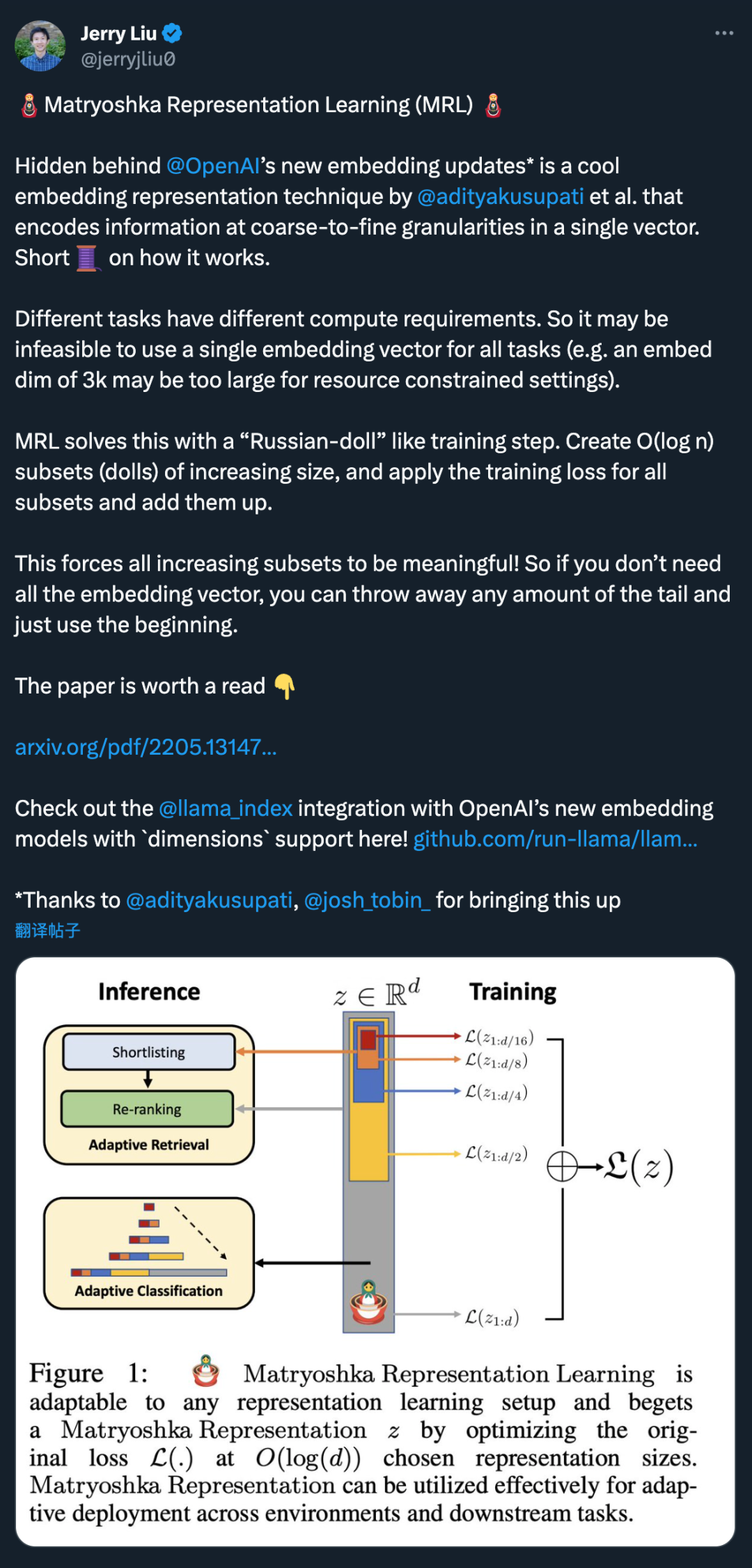
Hidden behind OpenAI’s new embedding model update is a cool one proposed by @adityakusupati et al. Embedding representation technology.
And Aditya Kusupati, one of the authors of MRL, also said: "OpenAI uses MRL by default in the v3 embedded API for retrieval and RAG! Other models and services should catch up soon."
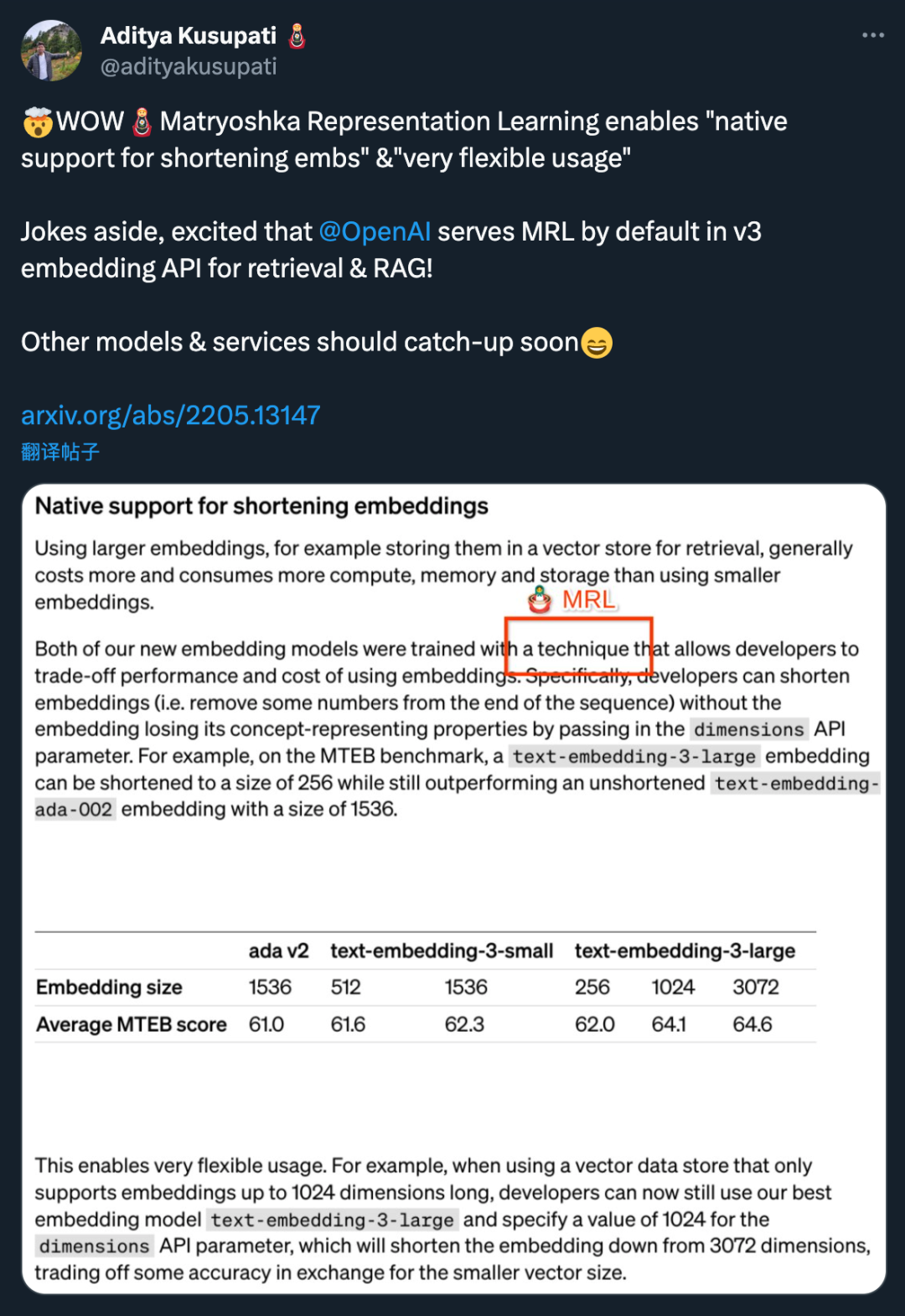
So what exactly is MRL? How's the effect? It’s all in the 2022 paper below.
MRL Paper Introduction
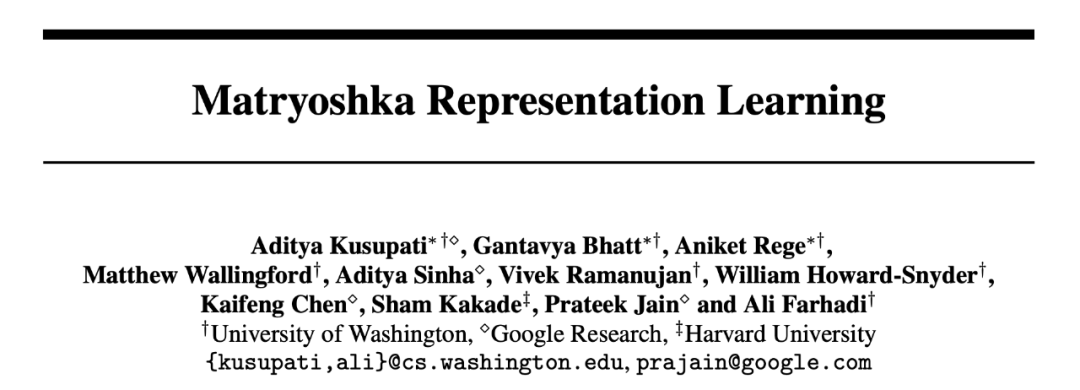
- ##Paper title: Matryoshka Representation Learning
- Paper link: https://arxiv.org/pdf/2205.13147.pdf
The question posed by the researchers is: Can a flexible representation method be designed to adapt to multiple downstream tasks with different computing resources?
MRL learns representations of different capacities in the same high-dimensional vector by explicitly optimizing O (log (d)) low-dimensional vectors in a nested manner, hence the name Matryoshka "Russian matryoshka doll". MRL can be adapted to any existing representation pipeline and can be easily extended to many standard tasks in computer vision and natural language processing.
Figure 1 shows the core idea of MRL and the adaptive deployment setup of the learned Matryoshka representation:

The first of Matryoshka representation An m-dimensions (m∈[d]) is an information-rich low-dimensional vector that requires no additional training cost and is as accurate as an independently trained m-dimensional representation. The information content of Matryoshka representations increases with increasing dimensionality, forming a coarse-to-fine representation without requiring extensive training or additional deployment overhead. MRL provides the required flexibility and multi-fidelity for characterizing vectors, ensuring a near-optimal trade-off between accuracy and computational effort. With these advantages, MRL can be deployed adaptively based on accuracy and computational constraints.
In this work, we focus on two key building blocks of real-world ML systems: large-scale classification and retrieval.
For classification, the researchers used adaptive cascades and used variable-size representations produced by models trained by MRL, which greatly reduced the time required to achieve a specific accuracy. Embedded average dimensionality. For example, on ImageNet-1K, MRL adaptive classification results in representation size reduction of up to 14x with the same accuracy as the baseline.
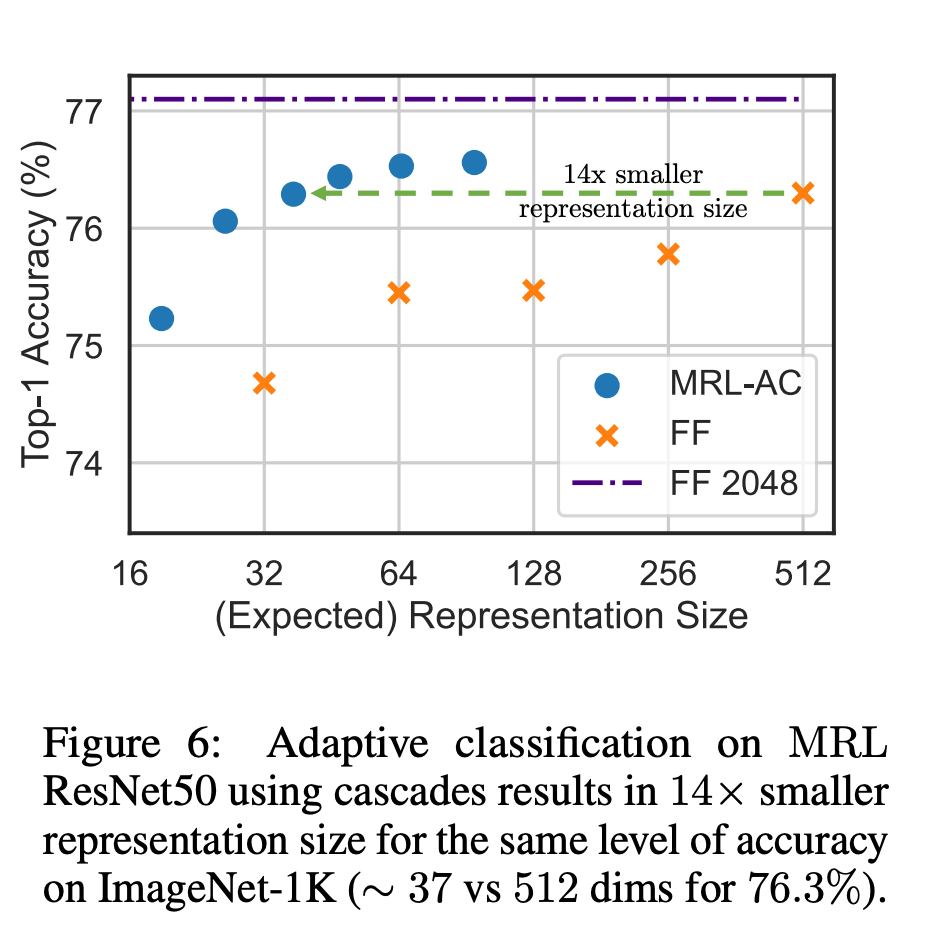
Similarly, researchers have also used MRL in adaptive retrieval systems. Given a query, the first few dimensions of the query embedding are used to filter the retrieval candidates, and then successively more dimensions are used to reorder the retrieval set. A simple implementation of this approach achieves 128x the theoretical speed in FLOPS and 14x the wall clock time compared to a single retrieval system using standard embedding vectors; it is important to note that the retrieval accuracy of MRL Comparable to the accuracy of a single retrieval (Section 4.3.1).
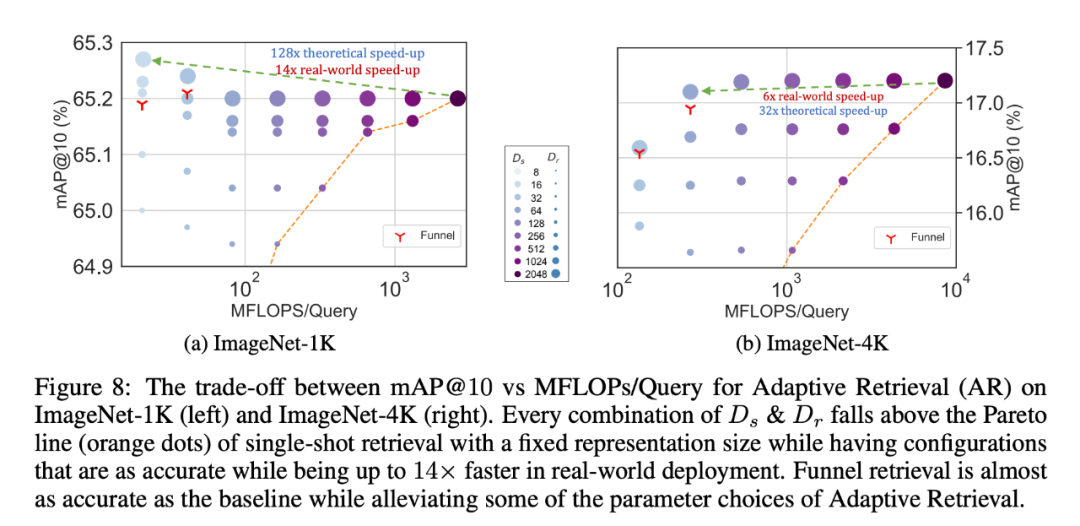
Finally, since MRL explicitly learns the representation vector from coarse to fine, intuitively it should be shared among different dimensions More semantic information (Figure 5). This is reflected in long-tail continuous learning settings, which can improve accuracy by up to 2% while being as robust as the original embeddings. In addition, due to the coarse-grained to fine-grained nature of MRL, it can also be used as a method to analyze the ease of instance classification and information bottlenecks.
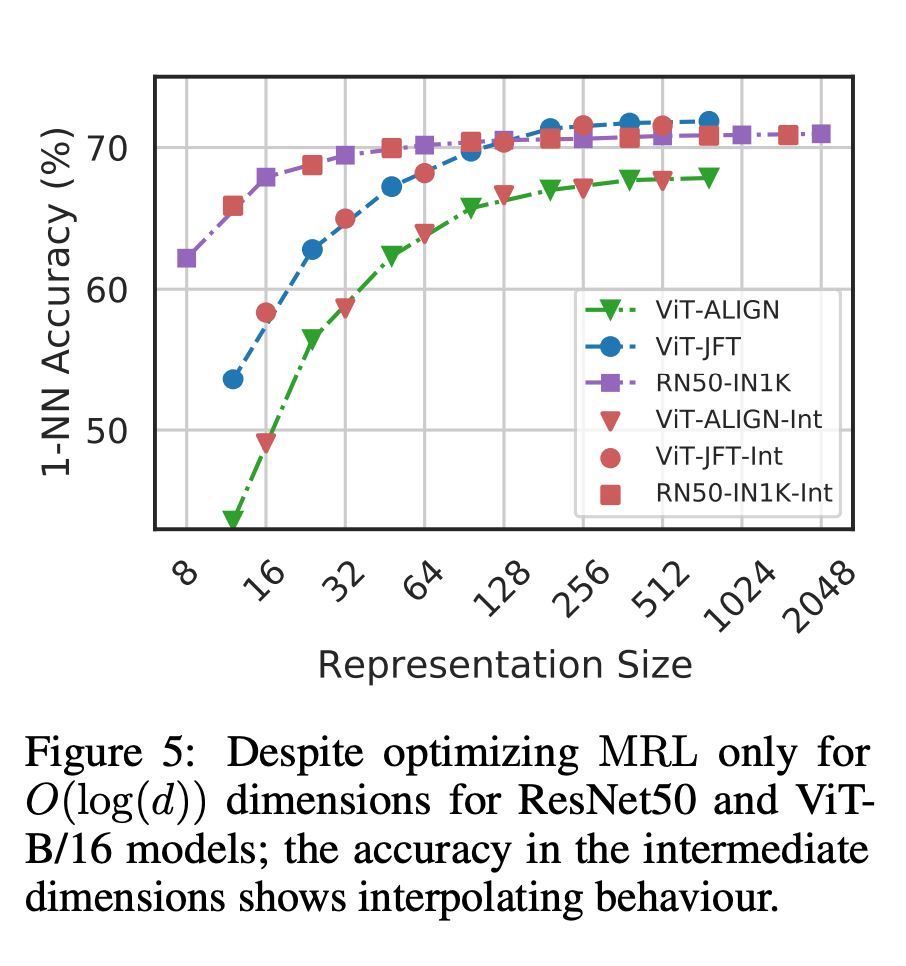
For more research details, please refer to the original text of the paper.
The above is the detailed content of Netizens exposed the embedding technology used in OpenAI's new model. For more information, please follow other related articles on the PHP Chinese website!

Hot AI Tools

Undresser.AI Undress
AI-powered app for creating realistic nude photos

AI Clothes Remover
Online AI tool for removing clothes from photos.

Undress AI Tool
Undress images for free

Clothoff.io
AI clothes remover

Video Face Swap
Swap faces in any video effortlessly with our completely free AI face swap tool!

Hot Article

Hot Tools

Notepad++7.3.1
Easy-to-use and free code editor

SublimeText3 Chinese version
Chinese version, very easy to use

Zend Studio 13.0.1
Powerful PHP integrated development environment

Dreamweaver CS6
Visual web development tools

SublimeText3 Mac version
God-level code editing software (SublimeText3)

Hot Topics
 WorldCoin (WLD) price forecast 2025-2031: Will WLD reach USD 4 by 2031?
Apr 21, 2025 pm 02:42 PM
WorldCoin (WLD) price forecast 2025-2031: Will WLD reach USD 4 by 2031?
Apr 21, 2025 pm 02:42 PM
WorldCoin (WLD) stands out in the cryptocurrency market with its unique biometric verification and privacy protection mechanisms, attracting the attention of many investors. WLD has performed outstandingly among altcoins with its innovative technologies, especially in combination with OpenAI artificial intelligence technology. But how will the digital assets behave in the next few years? Let's predict the future price of WLD together. The 2025 WLD price forecast is expected to achieve significant growth in WLD in 2025. Market analysis shows that the average WLD price may reach $1.31, with a maximum of $1.36. However, in a bear market, the price may fall to around $0.55. This growth expectation is mainly due to WorldCoin2.
 Why is the rise or fall of virtual currency prices? Why is the rise or fall of virtual currency prices?
Apr 21, 2025 am 08:57 AM
Why is the rise or fall of virtual currency prices? Why is the rise or fall of virtual currency prices?
Apr 21, 2025 am 08:57 AM
Factors of rising virtual currency prices include: 1. Increased market demand, 2. Decreased supply, 3. Stimulated positive news, 4. Optimistic market sentiment, 5. Macroeconomic environment; Decline factors include: 1. Decreased market demand, 2. Increased supply, 3. Strike of negative news, 4. Pessimistic market sentiment, 5. Macroeconomic environment.
 What does cross-chain transaction mean? What are the cross-chain transactions?
Apr 21, 2025 pm 11:39 PM
What does cross-chain transaction mean? What are the cross-chain transactions?
Apr 21, 2025 pm 11:39 PM
Exchanges that support cross-chain transactions: 1. Binance, 2. Uniswap, 3. SushiSwap, 4. Curve Finance, 5. Thorchain, 6. 1inch Exchange, 7. DLN Trade, these platforms support multi-chain asset transactions through various technologies.
 Aavenomics is a recommendation to modify the AAVE protocol token and introduce token repurchase, which has reached the quorum number of people.
Apr 21, 2025 pm 06:24 PM
Aavenomics is a recommendation to modify the AAVE protocol token and introduce token repurchase, which has reached the quorum number of people.
Apr 21, 2025 pm 06:24 PM
Aavenomics is a proposal to modify the AAVE protocol token and introduce token repos, which has implemented a quorum for AAVEDAO. Marc Zeller, founder of the AAVE Project Chain (ACI), announced this on X, noting that it marks a new era for the agreement. Marc Zeller, founder of the AAVE Chain Initiative (ACI), announced on X that the Aavenomics proposal includes modifying the AAVE protocol token and introducing token repos, has achieved a quorum for AAVEDAO. According to Zeller, this marks a new era for the agreement. AaveDao members voted overwhelmingly to support the proposal, which was 100 per week on Wednesday
 How to win KERNEL airdrop rewards on Binance Full process strategy
Apr 21, 2025 pm 01:03 PM
How to win KERNEL airdrop rewards on Binance Full process strategy
Apr 21, 2025 pm 01:03 PM
In the bustling world of cryptocurrencies, new opportunities always emerge. At present, KernelDAO (KERNEL) airdrop activity is attracting much attention and attracting the attention of many investors. So, what is the origin of this project? What benefits can BNB Holder get from it? Don't worry, the following will reveal it one by one for you.
 What is the analysis chart of Bitcoin finished product structure? How to draw?
Apr 21, 2025 pm 07:42 PM
What is the analysis chart of Bitcoin finished product structure? How to draw?
Apr 21, 2025 pm 07:42 PM
The steps to draw a Bitcoin structure analysis chart include: 1. Determine the purpose and audience of the drawing, 2. Select the right tool, 3. Design the framework and fill in the core components, 4. Refer to the existing template. Complete steps ensure that the chart is accurate and easy to understand.
 What are the hybrid blockchain trading platforms?
Apr 21, 2025 pm 11:36 PM
What are the hybrid blockchain trading platforms?
Apr 21, 2025 pm 11:36 PM
Suggestions for choosing a cryptocurrency exchange: 1. For liquidity requirements, priority is Binance, Gate.io or OKX, because of its order depth and strong volatility resistance. 2. Compliance and security, Coinbase, Kraken and Gemini have strict regulatory endorsement. 3. Innovative functions, KuCoin's soft staking and Bybit's derivative design are suitable for advanced users.
 Ranking of leveraged exchanges in the currency circle The latest recommendations of the top ten leveraged exchanges in the currency circle
Apr 21, 2025 pm 11:24 PM
Ranking of leveraged exchanges in the currency circle The latest recommendations of the top ten leveraged exchanges in the currency circle
Apr 21, 2025 pm 11:24 PM
The platforms that have outstanding performance in leveraged trading, security and user experience in 2025 are: 1. OKX, suitable for high-frequency traders, providing up to 100 times leverage; 2. Binance, suitable for multi-currency traders around the world, providing 125 times high leverage; 3. Gate.io, suitable for professional derivatives players, providing 100 times leverage; 4. Bitget, suitable for novices and social traders, providing up to 100 times leverage; 5. Kraken, suitable for steady investors, providing 5 times leverage; 6. Bybit, suitable for altcoin explorers, providing 20 times leverage; 7. KuCoin, suitable for low-cost traders, providing 10 times leverage; 8. Bitfinex, suitable for senior play






